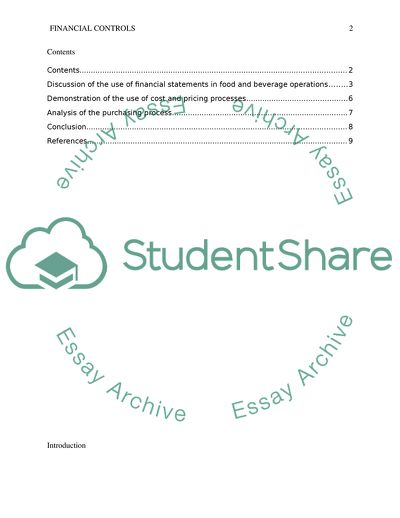Cite this document
(Financial Controls Used in Food and Beverage Operations Report, n.d.)
Financial Controls Used in Food and Beverage Operations Report. https://studentshare.org/tourism/1831652-2-the-financial-controls-used-in-food-and-beverage-operations-21discuss-the-use-of-financial-statements-in-food-and-beverage-operations-22demonstrate-the-use-of-cost-and-pricing-processes-23analyse-the-purchasing-process-possible-m1m2m3
Financial Controls Used in Food and Beverage Operations Report. https://studentshare.org/tourism/1831652-2-the-financial-controls-used-in-food-and-beverage-operations-21discuss-the-use-of-financial-statements-in-food-and-beverage-operations-22demonstrate-the-use-of-cost-and-pricing-processes-23analyse-the-purchasing-process-possible-m1m2m3
(Financial Controls Used in Food and Beverage Operations Report)
Financial Controls Used in Food and Beverage Operations Report. https://studentshare.org/tourism/1831652-2-the-financial-controls-used-in-food-and-beverage-operations-21discuss-the-use-of-financial-statements-in-food-and-beverage-operations-22demonstrate-the-use-of-cost-and-pricing-processes-23analyse-the-purchasing-process-possible-m1m2m3.
Financial Controls Used in Food and Beverage Operations Report. https://studentshare.org/tourism/1831652-2-the-financial-controls-used-in-food-and-beverage-operations-21discuss-the-use-of-financial-statements-in-food-and-beverage-operations-22demonstrate-the-use-of-cost-and-pricing-processes-23analyse-the-purchasing-process-possible-m1m2m3.
“Financial Controls Used in Food and Beverage Operations Report”. https://studentshare.org/tourism/1831652-2-the-financial-controls-used-in-food-and-beverage-operations-21discuss-the-use-of-financial-statements-in-food-and-beverage-operations-22demonstrate-the-use-of-cost-and-pricing-processes-23analyse-the-purchasing-process-possible-m1m2m3.


